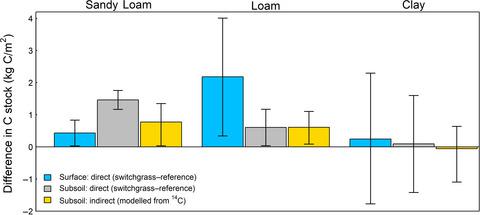当前位置:
X-MOL 学术
›
GCB Bioenergy
›
论文详情
Our official English website, www.x-mol.net, welcomes your
feedback! (Note: you will need to create a separate account there.)
Quantifying the effects of switchgrass (Panicum virgatum) on deep organic C stocks using natural abundance 14C in three marginal soils
Global Change Biology Bioenergy ( IF 5.9 ) Pub Date : 2020-08-07 , DOI: 10.1111/gcbb.12729 Eric W. Slessarev 1 , Erin E. Nuccio 1 , Karis J. McFarlane 1 , Christina E. Ramon 1 , Malay Saha 2 , Mary K. Firestone 3 , Jennifer Pett‐Ridge 1
Global Change Biology Bioenergy ( IF 5.9 ) Pub Date : 2020-08-07 , DOI: 10.1111/gcbb.12729 Eric W. Slessarev 1 , Erin E. Nuccio 1 , Karis J. McFarlane 1 , Christina E. Ramon 1 , Malay Saha 2 , Mary K. Firestone 3 , Jennifer Pett‐Ridge 1
Affiliation

|
Perennial bioenergy crops have been shown to increase soil organic carbon (SOC) stocks, potentially offsetting anthropogenic C emissions. The effects of perennial bioenergy crops on SOC are typically assessed at shallow depths (<30 cm), but the deep root systems of these crops may also have substantial effects on SOC stocks at greater depths. We hypothesized that deep (>30 cm) SOC stocks would be greater under bioenergy crops relative to stocks under shallow‐rooted conventional crop cover. To test this, we sampled soils to between 1‐ and 3‐m depth at three sites in Oklahoma with 10‐ to 20‐year‐old switchgrass (Panicum virgatum) stands, and collected paired samples from nearby fields cultivated with shallow rooted annual crops. We measured root biomass, total organic C, 14C, 13C, and other soil properties in three replicate soil cores in each field and used a mixing model to estimate the proportion of recently fixed C under switchgrass based on 14C. The subsoil C stock under switchgrass (defined over 500–1500 kg/m2 equivalent soil mass, approximately 30–100 cm depth) exceeded the subsoil stock in neighboring fields by 1.5 kg C/m2 at a sandy loam site, 0.6 kg C/m2 at a site with loam soils, and showed no significant difference at a third site with clay soils. Using the mixing model, we estimated that additional SOC introduced after switchgrass cultivation comprised 31% of the subsoil C stock at the sandy loam site, 22% at the loam site, and 0% at the clay site. These results suggest that switchgrass can contribute significantly to subsoil organic C—but also indicated that this effect varies across sites. Our analysis shows that agricultural strategies that emphasize deep‐rooted grass cultivars can increase soil C relative to conventional crops while expanding energy biomass production on marginal lands.
中文翻译:

使用天然丰度14C在三种边缘土壤中定量柳枝on(Panicum virgatum)对深层有机碳库的影响
多年生生物能源作物已显示出增加了土壤有机碳(SOC)储量,可能抵消了人为产生的C排放量。通常在浅深度(<30 cm)处评估多年生生物能源作物对SOC的影响,但这些作物的深根系统也可能在更大深度对SOC储量产生重大影响。我们假设在生物能源作物中,深层(> 30厘米)SOC储量相对于根深蒂固的常规作物覆盖下的储量要大。为了对此进行测试,我们在俄克拉荷马州的三个地点取样了深度为1至3 m的土壤,土壤位点为10至20年的柳枝stands (Panicum virgatum),并从附近种植了浅根一年生作物的田地中收集了成对的样本。我们测量了根生物量,总有机碳,14 C,13 C,以及每个田地中三个重复土壤核心的其他土壤特性,并使用混合模型基于14 C估算柳枝under下最近固定的C的比例。柳枝under下的底土C储量(定义为500-1500 kg / m以上)2个当量土壤质量,大约30–100 cm深度)在砂壤土站点上比邻近田间的地下土壤多出1.5 kg C / m 2,为0.6 kg C / m 2在壤土较多的地区,而在黏土的第三个地点没有明显差异。使用混合模型,我们估计柳枝cultivation种植后引入的额外SOC包括沙壤土位点下土C储量的31%,壤土位点22%和黏土位点0%。这些结果表明,柳枝switch可显着促进土壤中的有机碳,但也表明这种效应在不同地点之间存在差异。我们的分析表明,强调根深蒂固的草种的农业策略可以相对于传统作物增加土壤碳,同时扩大边际土地上的能源生物量生产。
更新日期:2020-08-07
中文翻译:

使用天然丰度14C在三种边缘土壤中定量柳枝on(Panicum virgatum)对深层有机碳库的影响
多年生生物能源作物已显示出增加了土壤有机碳(SOC)储量,可能抵消了人为产生的C排放量。通常在浅深度(<30 cm)处评估多年生生物能源作物对SOC的影响,但这些作物的深根系统也可能在更大深度对SOC储量产生重大影响。我们假设在生物能源作物中,深层(> 30厘米)SOC储量相对于根深蒂固的常规作物覆盖下的储量要大。为了对此进行测试,我们在俄克拉荷马州的三个地点取样了深度为1至3 m的土壤,土壤位点为10至20年的柳枝stands (Panicum virgatum),并从附近种植了浅根一年生作物的田地中收集了成对的样本。我们测量了根生物量,总有机碳,14 C,13 C,以及每个田地中三个重复土壤核心的其他土壤特性,并使用混合模型基于14 C估算柳枝under下最近固定的C的比例。柳枝under下的底土C储量(定义为500-1500 kg / m以上)2个当量土壤质量,大约30–100 cm深度)在砂壤土站点上比邻近田间的地下土壤多出1.5 kg C / m 2,为0.6 kg C / m 2在壤土较多的地区,而在黏土的第三个地点没有明显差异。使用混合模型,我们估计柳枝cultivation种植后引入的额外SOC包括沙壤土位点下土C储量的31%,壤土位点22%和黏土位点0%。这些结果表明,柳枝switch可显着促进土壤中的有机碳,但也表明这种效应在不同地点之间存在差异。我们的分析表明,强调根深蒂固的草种的农业策略可以相对于传统作物增加土壤碳,同时扩大边际土地上的能源生物量生产。











































 京公网安备 11010802027423号
京公网安备 11010802027423号